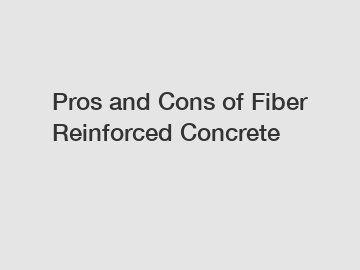Fiber reinforced concrete has become increasingly popular in the construction industry due to its many advantages. This innovative building material combines the strength and durability of traditional concrete with the added benefits of synthetic or natural fibers. These fibers are typically added to the concrete mix to improve its toughness, impact resistance, and flexibility. However, like any construction material, fiber reinforced concrete has its own set of pros and cons.
Let's start by discussing the pros of using fiber reinforced concrete. One of the main advantages of fiber reinforced concrete is its enhanced tensile strength. Traditional concrete is known for its high compressive strength but lacks the ability to withstand tensile stresses. By adding fibers to the mix, the concrete becomes more ductile and able to resist cracking under tension. This makes fiber reinforced concrete an ideal choice for structures that are subject to dynamic loads or seismic activity.
Another benefit of fiber reinforced concrete is its improved durability. The fibers act as a reinforcement system that helps prevent cracking and shrinkage, resulting in a more resilient and long-lasting material. This makes fiber reinforced concrete a cost-effective option in the long run, as it reduces the need for frequent repairs and maintenance.

Fiber reinforced concrete also offers greater impact resistance compared to traditional concrete. The fibers help absorb and distribute energy throughout the material, reducing the likelihood of damage from heavy impact or loading. This makes fiber reinforced concrete a suitable choice for structures that are exposed to high traffic or harsh environmental conditions.
In addition to its mechanical properties, fiber reinforced concrete also offers aesthetic benefits. The fibers can be added in various colors and textures, allowing for a more visually appealing finished product. This versatility in design makes fiber reinforced concrete a popular choice for decorative elements in buildings and architectural features.
Now, let's move on to the cons of using fiber reinforced concrete. One of the main drawbacks of fiber reinforced concrete is its higher upfront cost compared to traditional concrete. The addition of fibers can increase the overall material and labor expenses, making it less economical for some construction projects. However, the long-term benefits of durability and reduced maintenance costs can outweigh the initial investment.
Another potential downside of fiber reinforced concrete is its reduced workability. The presence of fibers in the mix can make it more difficult to place and finish the concrete, especially in intricate or complex forms. Contractors may need to adjust their construction techniques to accommodate the fibers, which can lead to longer construction times and increased labor costs.
Furthermore, the uniform distribution of fibers in the concrete mix can be challenging to achieve, resulting in variations in material properties and performance. Inconsistent fiber distribution can weaken the overall strength of the concrete and compromise its structural integrity. Proper mix design and quality control measures are essential to ensure a homogeneous and durable product.
Despite these drawbacks, the benefits of fiber reinforced concrete far outweigh the cons for many construction projects. Its superior strength, durability, and impact resistance make it a valuable material for a wide range of applications. With proper planning and execution, fiber reinforced concrete can provide a reliable and long-lasting solution for both structural and decorative needs.
In conclusion, fiber reinforced concrete is a versatile building material that offers numerous advantages for construction projects. Its enhanced tensile strength, durability, and impact resistance make it a preferred choice for many engineers and architects. While there are some challenges associated with using fiber reinforced concrete, the benefits of improved performance and longevity make it a worthwhile investment. By carefully considering the pros and cons of fiber reinforced concrete, contractors can make informed decisions and achieve successful outcomes in their construction endeavors.
If you are looking for more details, kindly visit nitric acid storage container, FRP Agitator Tank, long life fiberglass storage tank.





Comments
0